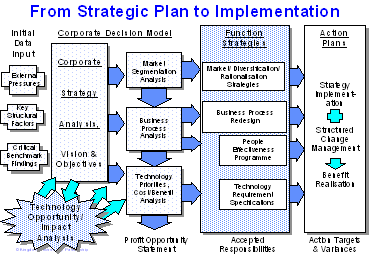Corporate and Technology Strategy - Realising Extra Value from the Existing Asset and Customer Base
for Chairman, Severomoravska Energetika, A.S., Ostrava, Czech Republic
April 1992 through October 1993
Objective: to advise on a technology strategy for the new market economy
The SME Board needed to develop a technology strategy to replace all of the systems made obsolete by the demise of the centrally planned economy. As we discovered as a result of our initial interviews on corporate vision and objectives, they also needed a corporate strategy to underpin and drive their technology choices. This business strategy needed to take into account the opportunities for using new technologies to broaden and rationalise their market offering. An objective of a later subsidiary project was to minimise disruption from new processes and the adaptation to radically new market conditions.
Methodology / Analytics: benchmarking review; analysis of customer behaviour; review of supply chain partner effectiveness; review and redesign of key business processes; software package selection and initiation of change management.
First, a business needs analysis provided a new corporate strategy which showed how to realise the value of the real assets of the company, including its customer base of major and minor business users and 1 million households, its electricity and information networks, the skills of its people and its geographical position, and its substantial cash flows. Changing customer needs and behaviour were analysed, as were the effectiveness of different supply chain partners. Key business processes were re-engineered for greater simplicity and customer satisfaction, and to take advantage of the potential for new technology. Investment projects were prioritised, suitable software was selected and a change management programme put in place. A noteworthy finding was that a 0.5% improvement in margin on electricity sales was equivalent to a 40% saving in workforce, so the Board felt confident to guarantee a programme of re-training and the avoidance of any compulsory redundancies.
Results: substantial profit and cash flow improvements identified and achieved, new systems implemented and innovations in supply chain introduced
Most of the potential profit improvements came from additional products and services which could increase the revenue from and utilisation of the existing asset and customer base, but direct benefits of technology-based process changes included a £15m potential improvement in cash flow and an immediate potential improvement in profits of £4.4m, including just under £1m which required no capital investment at all. Top management then moved to implement highly profitable supply chain innovations involving pioneering electricity trading between at least six different countries from Poland and the Ukraine to Switzerland.
(The above was a Kingdom Technology project, a business founded and managed since 1990 by Robin Hirsch.)
